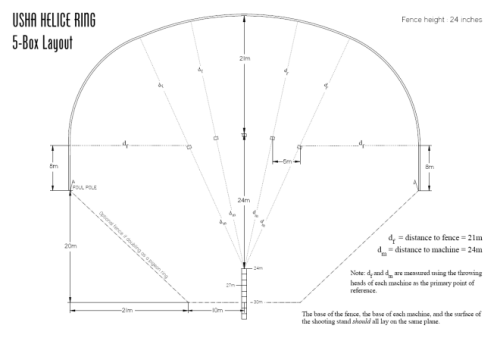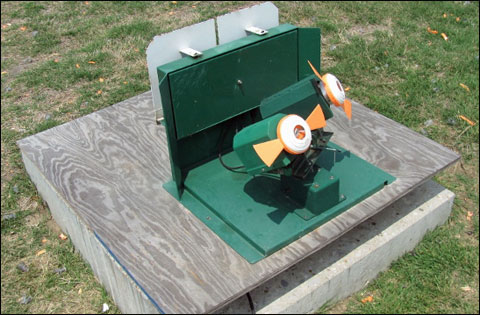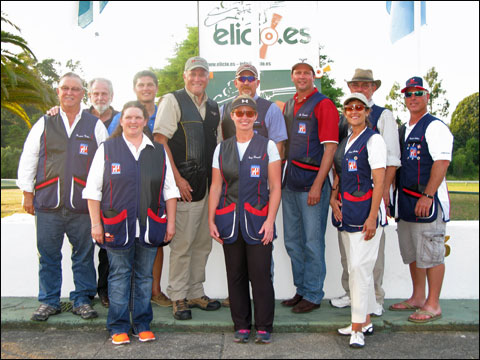How I Came to Love Helice

I remember vividly the first day I shot helice. I was at the Dallas Gun Club, training for an International Trap World Championship selection match when I heard some guys on the next field yelling, laughing, and making fun of each other between shots. It didn’t take long for me to get distracted, so between rounds, I wandered over to see what was going on. And by “wandered over,” I mean I finally stopped ignoring the grown men yelling, “Hey, girl, if you think THAT game is fun, come over here and shoot this one!”
I walked over to the next field, which didn’t look like any shooting field I’d ever seen. There was a two-foot fence that formed a circle, with the shooting station − only one station − on the perimeter of the ring. In front of the station, about 88 feet away, were seven machines in a line placed several feet apart. I watched one of the men shoot. He walked to the station, loaded his gun with two shells, and said “Ready?” At that point, I heard a trapper in a house behind him reply “Ready” and the shooter called for the target.

The blueprint for a regulation helice ring (source: USHA).
I wasn’t prepared for what I saw next. One of the machines (which didn’t look like any target machine I’d ever seen before) released a target that was orange and white and it was spinning. It looked like helicopter propellers, except it was spinning face-on − like a sporting clay teal with wings − making the target look much larger than a regular clay target. He fired, and I saw the target break into pieces.
At that moment, I knew I had to try it, and it’s been my favorite shooting game ever since.
I started shooting when I was 14 years old, and I didn’t want to shoot. My brother and his friends were preparing for the Texas State 4-H Shooting Sports Games one year when one of the team members couldn’t go. Since it was a team event and they needed another person, my dad nominated me. (And by “nominated,” I mean I didn’t have a choice.)
While preparing for the shoot that year, I fell in love with shooting. I wasn’t very good, but I was dedicated and willing to practice. As a result, I found myself invited to the Texas State Junior Olympics championships, then the National Junior Olympic Championship, where I won both ladies trap and ladies double trap, making the National Development team. Later on, I won USA Shooting’s National Championship in trap and shot on the Texas A&M Shotgun team, winning collegiate titles both individually and as a team in trap, skeet, and 5-stand. Currently, I hold the title of European Helice Champion and World Cup Champion. I don’t tell you that to brag − I just want you to understand that I’ve seen a lot targets fly. While I love all of the clay target games, and it’s not unusual to see me shooting skeet, trap, or sporting clays, by far, my favorite shooting game is helice.
Helice is a game meant to simulate live-pigeon shooting, which explains why the field is set up in a ring, similar to boxed-bird shooting. The orange and white helice target is actually made of plastic, and the orange and white are separate pieces that snap together to form a target. Once the shooter calls for the target to be released from one of the seven machines in front of them, and the target can go any direction except for directly at the shooter, at any height. The goal is to hit the target using up to two shells, separate the orange from the white piece, and the white piece must fall inside the ring for the target to be considered “dead.”

Helice targets and launcher.
The maximum load allowed under FITASC rules (yes, the same FITASC that governs sporting games) is 1 ounce, and most shooters elect to shoot 7½s. During a helice match in the US, a “race” is considered 30 birds. One of the hardest things for me to get used to, coming from games where I shot 100-200 targets in a day, was getting in the mindset of taking all day to shoot only 30 targets, and fewer than that when we shoot in Europe. During a 30-bird race, the shooter attempts five targets during one session on the shooting stand, then moves off for the next shooter. Depending on the number of rings at a range, the shooter will either move on to the next field or wait until the rest of the contestants rotate through before they shoot again.
There doesn’t seem to be a magic formula for the combination of things it takes to be a good helice shooter, but there are some common themes. Successful helice shooters are typically just good “gun pointers.” They are people who are fairly good shotgunners across all games, though we tend to draw more shooters from sporting clays, International events (skeet/trap), and of course, pigeon shooting.
Helice isn’t a game of “perfect.” The elusive 30 straight is a highly sought-after feat, and one could count on two hands the number of times it’s been done in the United States. In fact, for years, the United States Helice Association had a $5,000 straight purse available for anyone who could shoot a 30 straight at a sanctioned event. Successful helice shooters also have a strong mental game, and can easily adapt to change, as wind conditions and target draw can greatly affect hold points and timing strategy.

The author, front row left, with other members the 2013 US Helice Association National Team.
Helice is a growing sport, but is still not as readily available for practice as games like trap and skeet. The majority of helice rings are on private property and require an invitation to shoot if they are not hosting an event. The governing body for helice in the United States, the United States Helice Association, holds sanctioned matches throughout the year to select a team to represent the USA at the Match of Nations events held during the helice FITASC World Championship. These events are open to the public and a calendar of events can be found at www.ushelice.com. This year, matches have been held in Dallas, Houston, Winnsboro, Louisiana, and San Antonio, and future events will include matches in California and Kansas. Additionally, monthly “fun” shoots are held at the Dallas Gun Club and are open to the public, and if you sign up for the USHA email list, you’ll get information about other practice shoots.
I love the challenge of the game, I love that every target is different, and I love that this game forces me to be at the top of mine for every…single…shot. But I would be lying if I didn’t say that my favorite part of the game is spending time with the phenomenal people I get to shoot with. Helice shooters come from all walks of life: from farmers to lawyers, pilots to school teachers. I find that it’s a diverse group of people who share a lot of common values, who love our sport and are passionate about it, and who are doing everything they can to share it with others. With that being said, I believe I speak on behalf of all helice shooters when I say: come shoot with us! We love introducing people to the sport and hope that you’ll enjoy it as much as we do.
Mimi started shooting shotguns at age 14. She continued to shoot competitively through her undergraduate degree at Texas A&M University and her master’s at the University of Notre Dame, where she graduated with a BBA in marketing and a MBA. She’s shot all of the American disciplines competitively as well as been a member of the USA Shooting National team in bunker trap. Now, she shoots helice and is the current world and European Champion. She is on the board of directors for the United States Helice Association (http://www.ushelice.com) and can be reached at mimi@ushelice.com.

Mimi started shooting shotguns at age 14. She continued to shoot competitively through her undergraduate degree at Texas A&M University and her master’s at the University of Notre Dame, where she graduated with a BBA in marketing and a MBA. She’s shot all of the American disciplines competitively as well as been a member of the USA Shooting National team in bunker trap. Now, she shoots helice and is the current world and European Champion. She is on the board of directors for the United States Helice Association (http://www.ushelice.com) and can be reached at mimi@ushelice.com.


Comments